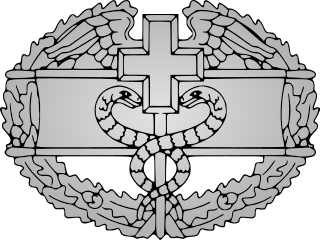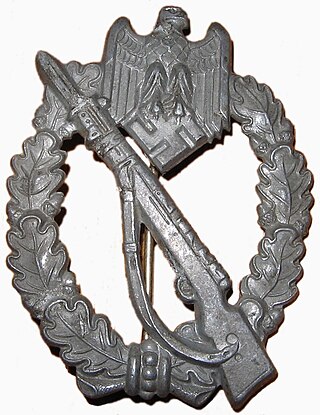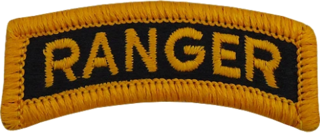
The Bronze Star Medal (BSM) is a United States Armed Forces decoration awarded to members of the United States Armed Forces for either heroic achievement, heroic service, meritorious achievement, or meritorious service in a combat zone.

Infantry is a specialization of military personnel who engage in warfare combat. Infantry generally consists of light infantry, irregular infantry, heavy infantry, mountain infantry, motorized infantry, mechanized infantry, airborne infantry, air assault infantry, and naval infantry. Other types of infantry, such as line infantry and mounted infantry, were once commonplace but fell out of favor in the 1800s with the invention of more accurate and powerful weapons.
The Combat Action Ribbon is a United States Navy, United States Coast Guard, and United States Marine Corps military decoration awarded to United States sea service members "who have actively participated in ground or surface combat." Coast Guardsmen, Navy sailors, and Marines active in clandestine, stealth or special operations are deemed eligible for consideration of the award. The ribbon is awarded to members of the Navy and Marine Corps with a rank no higher than captain and colonel, respectively.
A United States military occupation code, or a military occupational specialty code, is a nine-character code used in the United States Army and United States Marine Corps to identify a specific job. In the United States Air Force, a system of Air Force Specialty Codes (AFSC) is used. In the United States Navy, a system of naval ratings and designators are used along with the Navy Enlisted Classification (NEC) system. A system of ratings is also used in the United States Coast Guard.

A marksman is a person who is skilled in precision shooting. In modern military usage this typically refers to the use of projectile weapons such as an accurized scoped long gun such as designated marksman rifle to shoot at high-value targets at longer-than-usual ranges.
The Expert Infantryman Badge (EIB) is a special skills badge of the United States Army.

The Special Forces Tab is a service school qualification tab of the United States Army, awarded to any soldier completing the Special Forces Qualification Course at the U.S. Army John F. Kennedy Special Warfare Center and School, Fort Liberty, North Carolina. Soldiers who are awarded the Special Forces Tab are authorized to wear it, as well as the green beret for the remainder of their military careers, even when not serving in a Special Forces command.

The Combat Medical Badge is an award of the United States Army which was first created in January 1945. Any member of the Army Medical Department, at the rank of colonel or below, who is assigned or attached to a ground combat arms unit of brigade or smaller size which provides medical support during any period in which the unit was engaged in ground combat is eligible for the CMB. According to the award criterion, the individual must be performing medical duties while simultaneously being engaged by the enemy; strict adherence to this requirement and its interpretation will vary by unit. As of 3 June 2005, Special Forces medics are no longer eligible for award, but may now receive the Combat Infantryman Badge. A revision has allowed aviation medics to be eligible for the CMB. The non-combat proficiency equivalent is the Expert Field Medical Badge.

The Expert Field Medical Badge (EFMB) is a United States Army special skills badge first created on June 18, 1965. This badge is the non-combat equivalent of the Combat Medical Badge (CMB) and is awarded to U.S. military personnel and North Atlantic Treaty Organization (NATO) military personnel who successfully complete a set of qualification tests, including both written and performance portions. The EFMB is known for its adherence to its testing standards and, as such, requires strict attention to detail from candidates in order to receive a "GO" on its combat testing lanes. The pass rate for FY 2017 was 7%, making the EFMB one of the most difficult and prestigious Army special skill badges to earn.

The Parachutist Badge, also commonly referred to as "Jump Wings", is a military badge of the United States Armed Forces. Some services, such as the Marine Corps, officially refer to it as an insignia instead of a badge. The United States Space Force and United States Coast Guard are the only branches that do not award the Parachutist Badge, but their members are authorized to receive the Parachutist Badges of other services in accordance with their prescribed requirements. The DoD military services are all awarded the same Military Parachutist Badge. The U.S. Army and U.S. Air Force issue the same Senior and Master Parachutist Badges while the U.S. Navy and U.S. Marine Corps issue the Navy and Marine Corps Parachutist Insignia to advanced parachutists. The majority of the services earn their Military Parachutist Badge through the U.S. Army Airborne School.

The Combat Action Badge (CAB) is a United States military award given to soldiers of the U.S. Army of any rank and who are not members of an infantry, special forces, or medical MOS, for being "present and actively engaging or being engaged by the enemy and performing satisfactorily in accordance with prescribed rules of engagement" at any point in time after 18 September 2001.

The 9th Infantry Regiment ("Manchu") is a parent infantry regiment of the United States Army.

Unofficial badges of the United States military are those badges or emblems that do not appear in United States military regulations but that many individuals serving in the United States military wear or display. Unofficial badges may also be bestowed for a one time action or be authorized under the authority of a local commander.

The Infantry Assault Badge was a German military decoration awarded to Waffen-SS and Wehrmacht Heer soldiers during the Second World War. This decoration was instituted on 20 December 1939 by the Commander-in-Chief (Oberbefehlshaber) of the German Army, Generalfeldmarschall Walther von Brauchitsch. It could be awarded to members of infantry and Gebirgsjäger units that had participated in infantry assaults, with light infantry weapons, on at least three separate days of battle in the front line on or after 1 January 1940. When a counter-offensive led to fighting, it could also apply. Award of the Infantry Assault Badge was authorized at regimental command level, and mechanized or motorized infantry were not eligible for the original badge. A bronze variant of the Infantry Assault Badge was created in June 1940, authorized for motorized and mechanized infantry units, using similar requirements for award as the original silver variant. Non-infantry personnel were not eligible for either grade of the Infantry Assault Badge, but were eligible for other combat recognition badges, usually the General Assault Badge, Close Combat Clasp, or the Panzer Badge. The Luftwaffe would develop its own ground combat badge in 1942, the Ground Assault Badge.

Leo J. Meyer was a soldier in the United States Army, one of only three hundred and twenty-four men who have been awarded three Combat Infantryman Badges out of more than the twenty-three million men who served in the US Army between December 1941 and December 2007. Colonel Meyer was inducted into the U.S. Army Officer Candidate School Hall of Fame in 2009.

The Infantry Combat Badge (ICB) is awarded to serving members of the Australian Army for service as an Infantryman in warlike operations.

The Ranger Tab is a service school qualification tab of the United States Army, awarded to any soldier who completes Ranger School at the U.S. Army Fort Moore, Georgia. Soldiers who are awarded the Ranger Tab are authorized to wear it for the remainder of their military careers. The Ranger Tab is considered the pre-eminent award for soldiers in combat arms branches within the United States Army. It is considered an unwritten rule in the Infantry Branch that a Ranger Tab is required to achieve full career success, with the majority of commissioned and non-commissioned officers serving in battalion and above leadership roles holding the award.

In the United States Army, tabs are cloth and/or metal arches that are worn on U.S. Army uniforms, displaying a word or words signifying a special skill. On the Army Combat Uniform and Army Service Uniform, the tabs are worn above a unit's shoulder sleeve insignia (SSI) and are used to identify a unit's or a soldier's special skill(s) or are worn as part of a unit's SSI as part of its unique heritage. Individual tabs are also worn as small metal arches above or below medals or ribbons on dress uniforms.

The Infantryman Shoulder Cord is a United States military decoration worn over the right shoulder of all infantry-qualified U.S. Army soldiers. It is a fourragere in light blue, specifically PMS 5415, worn under the right shoulder and under the right epaulette of a U.S. Army infantry soldier's Class A dress blue uniform jacket or Class B shirt. The cord is composed of a series of alternating left and right half knots that are tied around a leader cord to form a "Solomon bar".
68W is the Military Occupational Specialty (MOS) for the United States Army's Combat Medic. 68Ws are primarily responsible for providing emergency medical treatment at point of wounding on the battlefield, limited primary care, and health protection and evacuation from a point of injury or illness. 68Ws are certified as Emergency Medical Technicians (EMT) through the National Registry of Emergency Medical Technicians (NREMT). However, 68Ws often have a scope of practice much wider than that of civilian EMTs. This specialty is open to males and females with minimum line scores of 107 GT and 101 ST on the Armed Services Vocational Aptitude Battery (ASVAB).

















